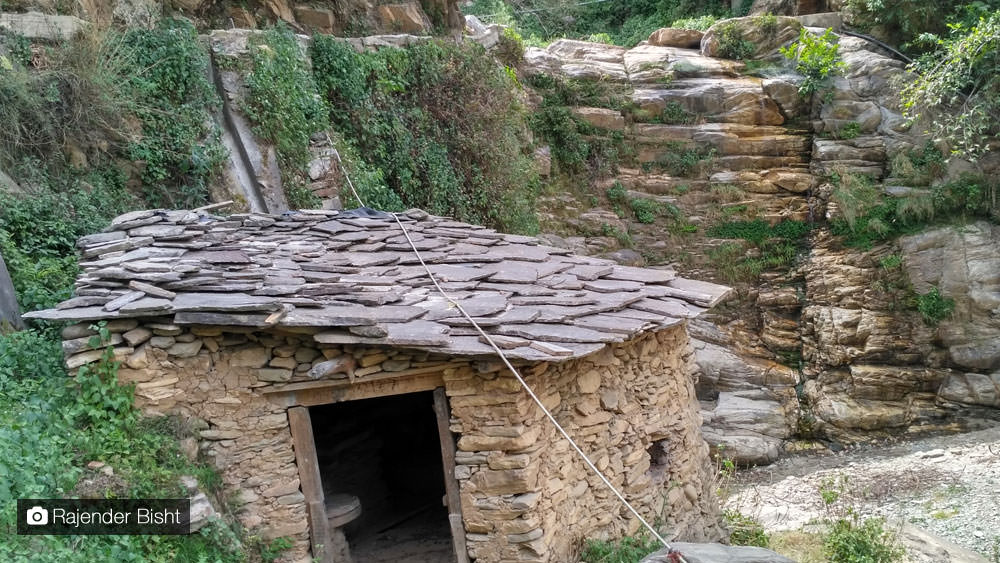I was walking along a fast running stream in the upper Himalayas of Uttarkashi district of Uttrakhand. The water was flowing in a calm and blissful way, humming songs in its soulful voice. While observing the calmness of the water, suddenly something caught my attention during the trek. I stopped for a while and kept staring at that thing. I started scratching my head really hard just to remind myself where I have seen this thing. After a brief struggle and retrospection, finally, I recalled what it was. The thing or structure in front of me was nothing but a Gharat.
I was intrigued by the mere glimpse and could not hold my urge to investigate it. As expected it was very old and dingy. I went inside it. It wasn’t functional and only ruins were left there. It seemed that it hasn’t been put to use for years. The nostalgia of witnessing this depreciated structure reminded me of my childhood days when as a kid I used to traverse distances with my Uncle to get our grains grinded in the Gharat. The pleasing sound made by the Gharat could be heard from a distance. It was such an exciting activity, I and my friends always waited for such an opportunity.

But seeing the disgraceful condition of this Gharat, I wonder how quickly the society has transformed over the years. Just a decade and half years back, most of the hill villages were not connected with electricity and kerosene lamps were the only hope to counter darkness. To conserve their precious resources, the locals would go to bed early and then wake up early in the morning.
After harvesting their crops especially wheat, the locals would carry big sacks of grains to grind in the Gharat which was both cheap and efficient. And since the electricity was still confined to cities, the possibility of any mechanical grinder was unthinkable. Rich or poor, upper or lower caste, the facility of the Gharat was at service to every customer. In exchange for the grinded grains, a meagre amount was charged which didn’t dig a hole in the pocket of the customers. My late grandfather once told me that in their times they used to get their quintals of grains grinded in just a few anna’s (1/16 rupee).
A gem of indigenous master class, Gharat are mills that run with the gravity flow of water. It was an alternative for mechanized mills of plains in highly undulating and challenging hilly terrains. Millstones are the basic machinery required to run the Gharat. As elaborated further in Wikipedia “Millstones or mill stones are stones used in gristmills, for grinding wheat or other grains. Millstones come in pairs. The runner stones spin above the stationary bed stones creating a “scissoring” or grinding action of the stones. A runner stone is generally slightly concave, while the bed stone is slightly convex.” The continuous flow of water makes the stationary stones to rotate. This action is somewhat similar to turbines which function on a rotatory motion.

Soon as the much-awaited development started penetrating in the remote villages of Uttarakhand, the engineers and policy makers with their vision of “putting the last first” began their developmental interventions. If any development was to follow in the far-flung areas, then electricity among all was a key component and the paramount necessity to connect remote inhabited villages. When electricity reached the villages, mechanized grinding machine made their way from cities to local town and villages. Due to its high efficiency, low time consumption and greater capacity, the new technology soon became very attractive. Moreover transporting the grain sacks was also simple as most of these machines were located near the roads.
Even though the new machines charges way more than Gharat but still, a majority began embracing the modern technology. In hills, unlike evergreen Gharat, these electricity run machines are vulnerable to power cuts. But nevertheless, people have become dependent on them. Like other indigenous technologies, our ancient technology lost its relevance to modern technology.
To further aggravate the problems, the government led dam construction projects across Uttarakhand have been obstructing the flow of water and streams have started becoming narrower and narrower. The minimum water flow required for functioning is not available these days. Amid the onslaught by anthropogenic activities, the climate change too is posing a threat to these streams. The glaciers are now receding from their existing places causing low availability of water in these streams.

Gharat in hills finds its mention in folk stories that were once an integral part of the villagers. There is a distinctive description of Gharat in the famous Jawaharlal Nehru Science Museum in Mumbai, where a model has been kept to illustrate the traditional science of ancient India. With its disappearance from hills, the future generation will be oblivious of any exposure to Gharat and its simple operation. Sadly for them, they might only find the relics in their history books or somewhere in a museum.
But even though technology is endangered now, efforts have been made to resurrect Gharat. There have been suggestions and attempts to turn these Gharats into micro-hydro power stations. The efforts are commendable but they face several challenges before they actually kick-off at a larger scale. But whatever new things are suggested, Gharat will always be remembered for its traditional grinding method. This traditional millstone machine is nearing to a sad demise. We’ll always have its blur image in our minds.
Note: This article has been written by Rajender Bisht